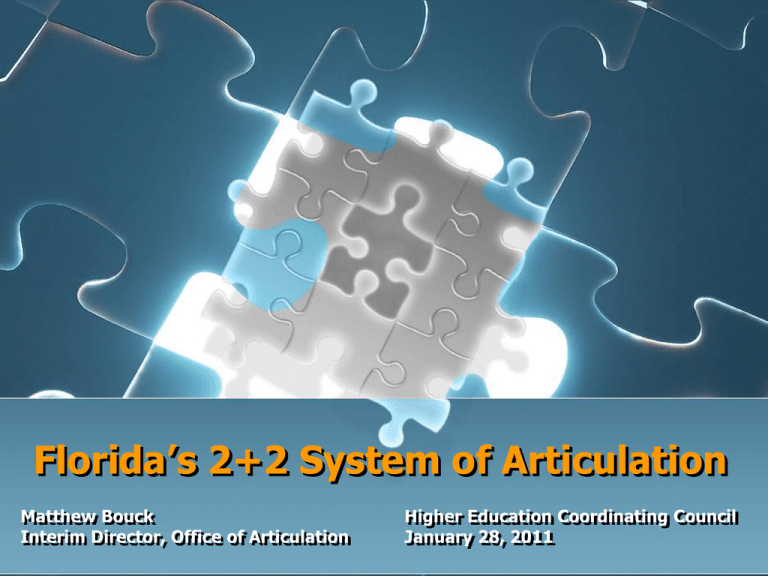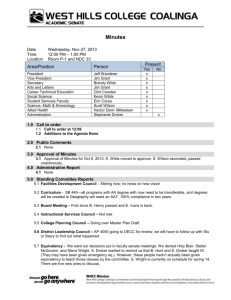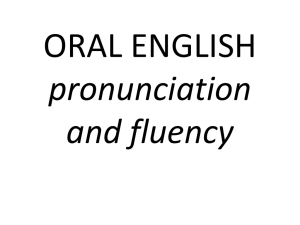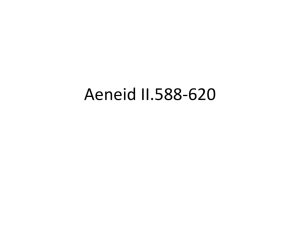Articulation: Removing Unnecessary Barriers
advertisement

Florida’s 2+2 System of Articulation Matthew Bouck Interim Director, Office of Articulation Higher Education Coordinating Council January 28, 2011 Joint Board Initiative Articulation Coordinating Committee Charge …the ACC is uniquely positioned to make policy recommendations that facilitate maximum coordination and adherence to statute as well as the state’s higher education strategic goals. …the ACC is being asked to review current policies, rules, and/or practices pertinent to the ability of students to move efficiently toward their degree goals… 2+2 Agreement Proposal: Binding agreement between the State Board of Education and Board of Governors rather than Rule and Regulation Phase I: “traditional” 2+2 transfer of AA degree, general articulation provisions and credit-by examination. Phase II: workforce education programs, including Associate in Science (AS) degree requirements and transfer, capstone degree articulation agreement, Applied Technology Diploma (ATD) transfer to associate degrees, and career ladder agreements—secondary, PSAV, and industry certification transfer to associate degree programs. Articulation Coordinating Committee 17 members 1 each from Board of Governors Office, Division of Florida Colleges, Division of Career and Adult Education, and Division of Public Schools Remainder appointed by Commissioner and SUS Chancellor: 4 State University System 4 Florida College System 1 Career and Technical Education 2 Secondary Education 2 Nonpublic Postsecondary Institutions Chair elected by the membership ACC Duties Serve as an advisory committee to the HECC, State Board of Education, and Board of Governors regarding: • • • • • • • • • • • Interinstitutional Articulation Agreements Articulation agreement and other articulation issues Articulation data and resulting policies Common prerequisites Dual enrollment-high school subject area equivalency Electronic transcripts Statewide articulation agreements Articulation accountability measures Credit-by-examination equivalencies FACTS.org – functions and usage Designation of a repository for articulation information General Education Each institution must establish a core curriculum of 36 hours in communication, humanities, mathematics, natural sciences, and social sciences for those working toward an Associate in Arts or baccalaureate degree. The integrity of that curriculum is recognized by other postsecondary institutions. Completion is recognized even without completion of the AA degree. If the student transfers prior to completion of the core curriculum, the general education program becomes the responsibility of the receiving institution. Gordon Rule and CLAS Requirements Gordon Rule Include 6A-10.030 Assessment Procedures for College-Level Communication and Computation Skills and relevant sections of Regulation 6.017 Criteria for Awarding the Baccalaureate Degree Six (6) semester hours of English and six (6) semester hours of additional coursework requiring college-level writing Six (6) semester hours of mathematics coursework at the level of College Algebra or higher CLAS Requirements Achievement of minimum standards for college-level communication and mathematics skills adopted in Rule 6A10.0311 and Regulation 6.017 Associate in Arts (AA) Degree The AA is the primary basis for admission of transfer students to the upper division Establishes the AA as completion of 60 hours to include 36 hours of general education coursework and 24 hours of appropriate common prerequisite and elective coursework. The 60 hours that comprise the AA shall be accepted in total upon transfer to the upper division. Requires a cumulative GPA of at least 2.0 for all courses attempted Grades of “D” shall transfer and count toward AA or baccalaureate degrees in the same way as “D” grades for native students. Statewide Course Numbering System All postsecondary courses for college credit, career credit, preparatory credit, and career preparatory credit shall be listed in the SCNS. Each course shall have a single identifying course number. Include provisions of 6A-10.0242 Procedures for Determining the Level at Which Courses Shall Be Classified. Provides criteria for lower vs. upper division coursework. Provides guidance to SCNS faculty committees in the selection of lower vs. upper division and equivalencies. Credit by Examination ACC will maintain a list of examinations, equivalent courses, and minimum scores and credits guaranteed to transfer. Guaranteed initial award of credit for AP, IB, AICE, and CLEP examinations. All credit by examination initially awarded based on ACC recommendations are guaranteed to transfer. Transfer credit is guaranteed for up to 45 hours provided it is in accordance with ACC recommendations. No grades or grade points are assigned for credit by examination. Credit by examination generated before ACC recommendations or those not listed in ACC document subject to the discretion of the receiving institution. Catalog Year in Effect and Electronic Transcripts Catalog Year in Effect Institutions must publish in official catalogs policies regarding admission, course, and prerequisite requirements of institution, unit, program, and specialization. The catalog in effect at time of initial collegiate enrollment governs upper division prerequisites in the same manner as native students provided student maintains continuous enrollment. Electronic Exchange of Student Transcripts and Associated Educational Records Mandates the Department, Board of Governors office, public postsecondary institutions, and school districts maintain an electronic exchange of student transcripts. Decision Points Guarantee every AA degree graduate admission to upper division in the SUS Current Rule Language: Every associate in arts graduate of a Florida community college shall be granted admission to an upper division program consistent with Section 1007.23, Florida Statutes. Admission to the student’s preferred public postsecondary institution or program is not guaranteed. Limited Access Programs Current Rule Language: Community college and state university transfer students shall have the same opportunity to enroll in baccalaureate limited access programs as native students. Baccalaureate limited access program selection and enrollment criteria shall be established and published in catalogs, counseling manuals, and other appropriate publications. A list of limited access programs shall be filed annually with the Articulation Coordinating Committee.











